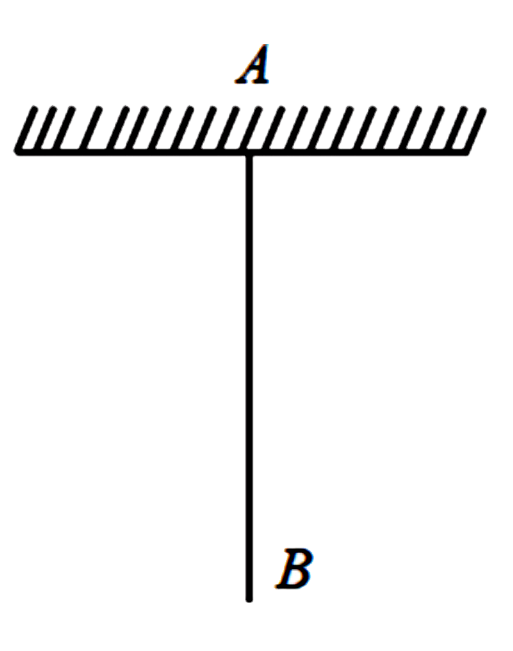The young's modulus of a wire of length (L) and radius (r ) is Y. If the length is reduced toL2 and radius r2 , then its young's modulus will be
Y2
Y
2Y
4Y
The correct Answer is:B
To solve the problem, we need to understand the relationship between Young's modulus and the dimensions of the wire. Let's go through the solution step by step.
Step 1: Understand Young's Modulus
Young's modulus (Y) is defined as the ratio of stress to strain in a material. It is given by the formula:
Y=StressStrain
where:
- Stress = FA (Force per unit area)
- Strain = ΔLL (Change in length per original length)
Step 2: Analyze the Initial Conditions
Initially, the wire has:
- Length = L
- Radius = r
The cross-sectional area A of the wire can be calculated using the formula for the area of a circle:
A=πr2
Thus, the initial stress (σ) can be expressed as:
σ=Fπr2
Step 3: Analyze the New Conditions
Now, the length of the wire is reduced to L/2 and the radius is reduced to r/2.
The new cross-sectional area A′ becomes:
A′=π(r2)2=πr24=πr24
The new stress (σ′) is:
σ′=FA′=Fπr24=4Fπr2
Step 4: Calculate the New Strain
The new strain (ϵ′) is calculated as:
ϵ′=ΔL′L′=L/2L/2=1
Step 5: Determine Young's Modulus in New Conditions
Now we can find the new Young's modulus Y′:
Y′=σ′ϵ′=4F/πr21=4Fπr2
Step 6: Compare Young's Modulus
Notice that the new Young's modulus Y′ is still dependent on the material properties and does not change with the dimensions of the wire. Thus:
Y′=Y
Conclusion
The Young's modulus remains the same regardless of the changes in length and radius. Therefore, the answer is:
Young's modulus after changes=Y
Final Answer
The Young's modulus will remain Y.
---
Young's modulus (Y) is defined as the ratio of stress to strain in a material. It is given by the formula:
Y=StressStrain
where:
- Stress = FA (Force per unit area)
- Strain = ΔLL (Change in length per original length)
Initially, the wire has:
- Length = L
- Radius = r
A=πr2
Thus, the initial stress (σ) can be expressed as:
σ=Fπr2
Now, the length of the wire is reduced to L/2 and the radius is reduced to r/2.
A′=π(r2)2=πr24=πr24
σ′=FA′=Fπr24=4Fπr2
The new strain (ϵ′) is calculated as:
ϵ′=ΔL′L′=L/2L/2=1
Now we can find the new Young's modulus Y′:
Y′=σ′ϵ′=4F/πr21=4Fπr2
Notice that the new Young's modulus Y′ is still dependent on the material properties and does not change with the dimensions of the wire. Thus:
Y′=Y
The Young's modulus remains the same regardless of the changes in length and radius. Therefore, the answer is:
Young's modulus after changes=Y
The Young's modulus will remain Y.
Topper's Solved these Questions
- MECHANICAL PROPERTIES OF SOLIDSBOOK - NCERT FINGERTPS ENGLISHCHAPTER - MECHANICAL PROPERTIES OF SOLIDSEXERCISE - APPLICATIONS OF ELASTIC BEHAVIOUR OF MATERIALS
8 Videos
- MECHANICAL PROPERTIES OF SOLIDSBOOK - NCERT FINGERTPS ENGLISHCHAPTER - MECHANICAL PROPERTIES OF SOLIDSEXERCISE - HOTS
8 Videos
- MECHANICAL PROPERTIES OF SOLIDSBOOK - NCERT FINGERTPS ENGLISHCHAPTER - MECHANICAL PROPERTIES OF SOLIDSEXERCISE - STRESS-STRAIN CURVE
5 Videos
- MECHANICAL PROPERTIES OF FLUIDSBOOK - NCERT FINGERTPS ENGLISHCHAPTER - MECHANICAL PROPERTIES OF FLUIDSEXERCISE - NCERT Exemplar
5 Videos
- MOTION IN A PLANE BOOK - NCERT FINGERTPS ENGLISHCHAPTER - MOTION IN A PLANE EXERCISE - Assertion And Reason
15 Videos
Similar Questions
Knowledge Check
Young's modulus of a wire depends on
Adiameter of the wireBmass hanging from the wireClength of the wireDÂ material of the wire
The Young's modulus of a wire Y. If the energy per unit volume is E, then the strain will be
View SolutionThe Young's modulus of the material of a wire is equal ot the
View SolutionA steel wire is stretched by 1kgwt. If the radius of the wire is doubled, its Young's modulus will
View SolutionA uniform ring of radius R and made up of a wire of cross - sectional radius r is rotated about its axis with a frequency f. If density of the wire is ρ and young's modulus is Y . Find the fractional change in radius of the ring .
View SolutionWhat will be the stress required to double the length of a wire of Young's modulus Y?
View SolutionA bar of mass m and length l is hanging from point A as shown in the figure . If the Young's modulus of elasticity of the bar is Y and area of cross - section of the wire is A, then the increase in its length due to its own weight will be

View SolutionA wire of length L and radius a rigidlyl fixed at one end. On stretching the other end of the wire with a force F, the increase in its length is L, if another wire of same material but of length 2 L and radius 2 a is stretched with a force 2 F, the increase in its length will be
View Solution
